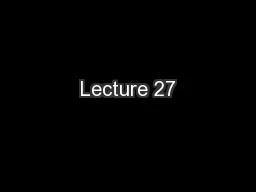

Molecular orbital theory III Applications of MO theory Previously we learned the bonding in H 2 We also learned how to obtain the energies and expansion coefficients of LCAO MOs which amounts to solving a matrix eigenvalue equation ID: 474372
Download Presentation The PPT/PDF document "Lecture 27" is the property of its rightful owner. Permission is granted to download and print the materials on this web site for personal, non-commercial use only, and to display it on your personal computer provided you do not modify the materials and that you retain all copyright notices contained in the materials. By downloading content from our website, you accept the terms of this agreement.
Slide1
Lecture 27
Molecular orbital theory IIISlide2
Applications of MO theory
Previously, we learned the bonding in H
2
+
.
We also learned how to obtain the energies and expansion coefficients of LCAO MO’s, which amounts to solving a matrix eigenvalue equation.
We will apply these to
homonuclear
diatomic molecules
,
heteronuclear
diatomic molecules
, and
conjugated π-electron molecules
.Slide3
MO theory for H
2
+
(review)
φ
+
=
N+(A+B)
bonding
φ– = N–(A–B)
anti-bonding
φ
–
is more anti-bonding
than
φ
+ is bonding
E1s
RSlide4
MO theory for H
2
+
and H
2
MO diagram for H2+ and H2 (analogous to aufbau
principle for atomic configurations)
Reflecting: anti-bonding orbital is more anti-bonding than bonding orbital is bondingH2+
H2Slide5
Matrix eigenvalue eqn. (review)Slide6
MO theory for H
2
α
is the
1
s
orbital energy.
β
is negative.
anti-bonding orbital is more anti-bonding than bonding orbital is bonding.Slide7
MO theory for H
2Slide8
MO theory for He
2
and He
2
+
He2 has no covalent bond (but has an extremely weak dispersion or van der Waals attractive interaction). He2+ is expected to be bound.
He
2He2+Slide9
A
π
bond is weaker than
σ
bond because of a less orbital overlap in
π
.
σ
and π bondsσ bond
π bondSlide10
MO theory for Ne
2
, F
2
and O
2
Ne
2
F
2
O
2
Hund’s
rule
O
2
is magneticSlide11
MO theory for N
2
, C
2
,
and B
2
N2
C
2
B
2
Hund’s
rule
B
2
is magneticSlide12
Polar bond in HF
The
bond
in hydrogen fluoride is
covalent but also
ionic (Hδ+Fδ–).H 1
s and F 2p form the bond, but they have uneven weights in LCAO MO’s .
Hδ+Fδ–Slide13
Polar bond in HF
Calculate the
LCAO MO’s and
energies of the
σ
orbitals in the HF molecule, taking β = –1.0 eV and the following ionization
energies (α’s): H1s
13.6 eV, F2p 18.6 eV. Assume S = 0. Slide14
Matrix eigenvalue eqn. (review)
With
S =
0,Slide15
Polar bond in HF
Ionization energies give us the depth of
AO
’
s, which correspond to −α
H1s and −αF2p.Slide16
H
ückel
approximation
We consider LCAO MO’s constructed from just the
π orbitals of planar sp
2 hybridized hydrocarbons (σ orbitals not considered)We analyze the effect of π electron conjugation.Each
pz orbital has the same .Only the nearest neighbor pz
orbitals have nonzero .
Centered on the nearest neighbor carbon atomsSlide17
Ethylene (isolated π bond)
α
α
β
Resonance integral
(negative)
Coulomb integral of 2
p
zSlide18
Ethylene (isolated π bond)Slide19
Butadiene
1
2
β
3
4
β
β
1 2 3 4
4
3
2 1Slide20
Butadiene
Two conjugated
π
bonds
Two isolated
π
bonds
extra 0.48
β
stabilization =
π delocalizationSlide21
Cyclobutadiene
1
2
β
4
3
β
β
β
1 2 3 4
4
3
2 1Slide22
Cyclobutadiene
No delocalization
energy; no
aromaticitySlide23
Cyclobutadiene
β
1
β
1
β
2
β
2
1
2
4
3
1 2 3 4
4
3
2 1Slide24
Cyclobutadiene
Spontaneous distortion from square to rectangle?Slide25
Homework challenge #8
Is
cyclobutadiene
square or rectangular? Is it planar or buckled? Is its ground state singlet or triplet?
Find experimental and computational research literature on these questions and report.
Perform MO calculations yourself (use the NWCHEM software freely distributed by Pacific Northwest National Laboratory). Slide26
Summary
We have applied numerical techniques of MO theory to
homonuclear
diatomic molecules,
heteronuclear
diatomic molecules, and conjugated π electron systems.These applications have explained molecular electronic configurations, polar bonds, added stability due to π electron delocalization in butadiene, and the lack thereof in
cyclobutadiene.Acknowledgment:
Mathematica (Wolfram Research) & NWCHEM (Pacific Northwest National Laboratory)